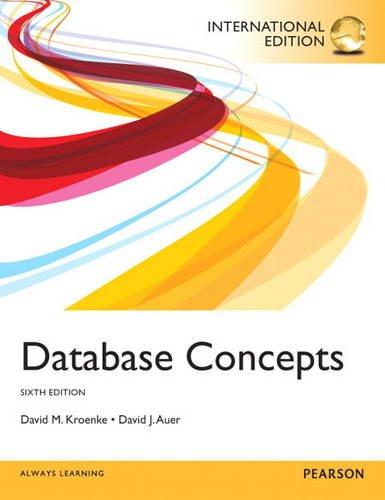Answered step by step
Verified Expert Solution
Question
1 Approved Answer
The ER diagram consists of several entities and their relationships, as follows: Person entity: The person entity serves as the superclass for all four groups
The ER diagram consists of several entities and their relationships, as follows:
Person entity: The person entity serves as the superclass for all four groups of persons, namely employees, physicians, patients, and volunteers. It has the following attributes: PersonID identifier Name, StreetAddress, City, State, Zip, BirthDate, and Phone.
Employee entity: The employee entity is a subclass of the person entity and has a relationship of is a with the person entity. It has the following attributes: DateHired. Employees are further subdivided into three groups, namely nurses, staff, and technicians.
Nurse entity: The nurse entity is a subclass of the employee entity and has a relationship of is a with the employee entity. It has the following attribute: Certificate. Each nurse is assigned to one care center. The nurse entity has a relationship of "works at with the care center entity.
Staff entity: The staff entity is a subclass of the employee entity and has a relationship of is a with the employee entity. It has the following attribute: JobClass.
Technician entity: The technician entity is a subclass of the employee entity and has a relationship of is a with the employee entity. It has the following attribute: Skill. Each technician is assigned to one or more laboratories. The technician entity has a relationship of "works at with the laboratory entity.
Physician entity: The physician entity is a subclass of the person entity and has a relationship of is a with the person entity. It has the following attributes: Specialty and Pager#
Patient entity: The patient entity is a subclass of the person entity and has a relationship of is a with the person entity. It has the following attribute: Contactdate.
Volunteer entity: The volunteer entity is a subclass of the person entity and has a relationship of is a with the person entity. It has the following attribute: Skill.
Care center entity: The care center entity has the following attributes: Name identifier and Location. A care center may have one or more nurses assigned to it The care center entity has a relationship of "has" with the nurse entity. Also, for each care center, one of the nurses assigned to that care center is appointed as the nurseincharge. The care center entity has a relationship of is managed by with the nurse entity.
Laboratory entity: The laboratory entity has the following attributes: Name identifier and Location. A laboratory must have at least one technician assigned to it and may have any number of technicians assigned. The laboratory entity has a relationship of "has" with the technician entity.
Bed entity: The bed entity has the following attributes: BedID identifier and MaintenanceTime. BedID is a composite attribute, with components Bed# and Room# There may be no beds assigned to a care center, or a care center may have one or more beds up to any number assigned to it The bed entity has a relationship of is assigned to with the care center entity.
The ER diagram reflects the relationships between these entities based on the business rules described in the project description.
Step by Step Solution
There are 3 Steps involved in it
Step: 1

Get Instant Access to Expert-Tailored Solutions
See step-by-step solutions with expert insights and AI powered tools for academic success
Step: 2

Step: 3

Ace Your Homework with AI
Get the answers you need in no time with our AI-driven, step-by-step assistance
Get Started


